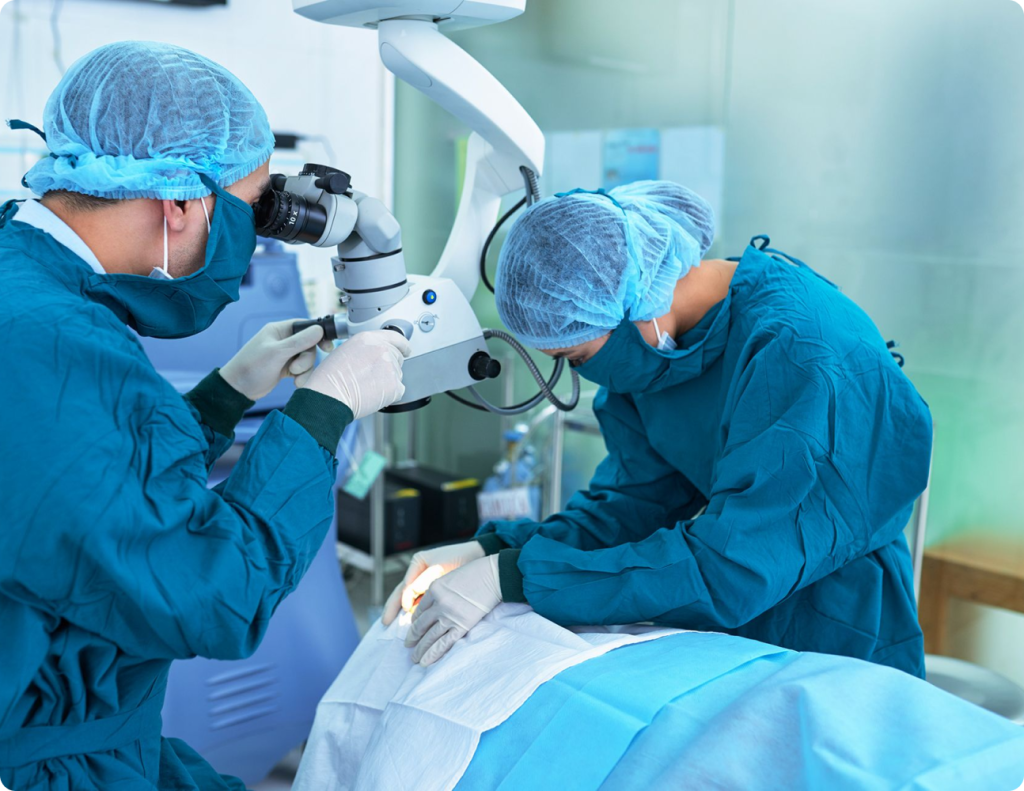Over 1.4 million people have cataract surgery each year in the United States, 95% of them without complications. Here at North Dallas Eye Associates we use only the most up-to-date surgical techniques. Almost all cases are done with a minimum of intravenous anesthesia for safety, and eyedrops to numb your eye. This is very effective, and all that is necessary to make surgery essentially painless. The cloudy cataract lens is removed with a machine that uses ultrasound energy to break it up into pieces which are then vacuumed out. Although it is a common misconception, lasers are not used to remove cataracts. A permanent lens implant is then placed into the eye, so that you can see without thick “coke-bottle” glasses. After surgery, approximately 20% of people have a clouding of the natural capsule membrane that supports the lens implant. Laser surgery can be used to open this cloudy capsule, restoring clear vision. After cataract surgery, you will use drops for a few weeks, but otherwise you can soon return to your normal activities. Cataract surgery is a highly successful procedure, with improved vision in 95% of patients. It is surgery, and therefore it is possible for complications to occur, some severe enough to limit vision. It is important to discuss all options with your ophthalmologist before deciding if cataract surgery is appropriate for you.
CATARACT SURGERY

Over time, our natural lens becomes cloudy and hardened – a condition know as a cataract. Although cataracts can compromise visual clarity and quality, surgical treatment is quick and easy.
Our surgeons are experts in advanced, laser-assisted cataract removal.
At the time of surgery, you will receive a new, Intraocular Lens (IOL). Our surgeons are leaders in Advanced Technology IOL implantation, and can help you dramatically reduce your dependence on eyeglasses!
Following cataract surgery, a hazy film may develop behind your lens implant, and once again impair your vision. But with a quick YAG Laser procedure, our surgeons can restore your sight.
Frequently Ask Questions
The most common type of cataract is related to aging of the eye. Other causes of cataract include: Family history of cataract at a young age; Medical problems, such as diabetes; Injury to the eye; Medications, such as steroids; Long-term, unprotected exposure to sunlight; Previous eye surgery; Cigarette smoking.
During a thorough eye examination with dilation, your ophthalmologist can detect the presence and extent of a cataract, as well as any other conditions in your eye that may be causing blurred vision. There may be other reasons in addition to the cataract, including problems with the retina or optic nerve. If these are indeed present, removal of the cataract may not result in any significant improvement in your vision. Your ophthalmologist can make this determination and tell you how much visual improvement to expect.
How quickly a cataract develops varies among individuals. Most cataracts gradually worsen over a period of years. Other cataracts, such as those with diabetes and in young people, may rapidly worsen over months and even sometimes weeks.
Surgery is the only way to remove a cataract from your eye. If symptoms are mild, a change in glasses may be able to allow you to function comfortably. There are no medications, dietary supplements or exercises that have been shown to prevent cataract formation. Protection from ultraviolet light (sunlight) may help prevent or slow progression of a cataract. Always wear sunglasses that have ultraviolet (UV) protection when out in the sun.
Cataract surgery should be considered when the blurring of your vision is interfering with daily activities such as driving a car or reading. It is not true that a cataract needs to be “ripe” before it can be removed. Cataract surgery is an elective procedure, and so a decision between yourself and your ophthalmologist is necessary to decide when is the best time for you.
